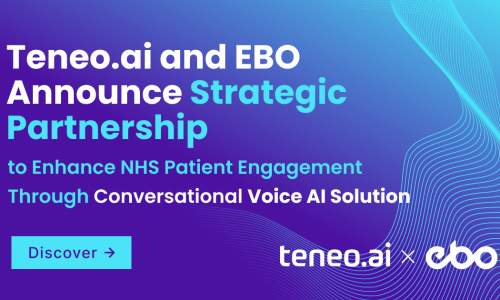Artificial Intelligence (AI) is set to revolutionise healthcare. From reading MRIs for cancer detection to identifying patients that need more help to avoiding unnecessary admissions to hospital, AI has the potential to enhance outcomes in most clinical fields. But what about patient communications?
NHS hospitals communicate with thousands of patients every day and it is this communication with patients that shapes the patients’ experience of their care1. Good clinical care alone, is not sufficient for a positive patient experience. NHS administrative processes can be onerous for patients at best, at their worst they can even restrict access to care1. This can impact clinical outcomes as patients become disengaged with their care1,2.
Even the least technically savvy of patients nowadays are used to having information at their fingertips and are less and less willing to spend precious time waiting on the phone. Many NHS patients have been waiting several months and even years for their treatment with very little communication with their NHS Trust.
So how can hospitals harness AI to meet patients’ communication and information needs?
To grow an AI-led digital communications strategy the best thing to do, is to start simple and build a solid foundation.
Step 1: Open Your Digital Front Door to Patients
An AI-powered Virtual Assistant on the Trust’s main webpage – the digital front door – is a perfect start and an easy quick win for any NHS Trust. Patients can use it to check their appointment details, get answers to simple queries and find out how to get to their appointment. At the same time, the Virtual Assistant can start to learn what is important for patients locally.
Step 2: Provide an all-knowing AI Virtual Assistant
Over some months, an AI-driven Virtual Assistant can be developed into an all-knowing assistant for patients that answers complex queries, lets them know how to prepare for their appointments, collects e-Consent, provides information to help with self-care and even helps them complete pre-assessment forms.
Step 3: Reduce DNAs via Self-Scheduling
Once patients are able to confirm their appointment information easily, the obvious next step is moving to self-scheduling. Hospital contact centres are very busy, which makes it difficult for patients to reschedule and cancel appointments when they need to. This fuels missed appointments and DNAs but can be easily remedied by allowing patients to choose their appointment slots and reschedule easily when circumstances change 3 .
Step 4: Maximise Benefits with Robotic Process Automation (RPA)
Benefits to patients and the Trust are maximised once the entire communications pathway is digitised and processes are fully automated. This strategy leverages RPA to streamline workflows and minimise the work required from administrative staff while allowing optimal levels of patient communications at scale.
At this point, patients are able to self-refer by chatting to the Virtual Assistant on the Trust website. They are contacted regularly automatically to make sure they are waiting well and still need an appointment. They reschedule their appointments using the Virtual Assistant and can choose to be contacted when an earlier slot is freed up so that they can be seen sooner. Clinicians are notified directly when a patient reports a worrying symptom or cancels a key appointment.
What tools do hospitals need to do this?
The tool required for this full automation of communication with patients to work is a simple and friendly patient facing chatbot interface that sits on a highly intelligent AI-driven solution. It allows information from the EPR to flow seamlessly between patient conversations and the clinical record. Patients can ask questions, complete forms directly into the EPR, book appointments and retrieve documents to view from their record, all from the comfort of their sitting room at 10pm.
An AI-driven Virtual Assistant works around the clock and has thousands of conversations all at once, making sure that human staff can focus on more complex patient care. Thanks to automation, administrators spend less time on tedious tasks like registering patients and uploading information into the EPR. Clinicians spend less time completing forms and patients get a timely answer every time they contact their Trust.
Interested in finding out more?
Contact us to find out how EBO’s AI solution can help you to digitise your patient communications, increase efficiency and work capacity and decrease costs. Alternatively, you can start your AI automation journey by downloading our guide to AI for healthcare.
References:
- Patient Experience Drivers of Overall Satisfaction With Care in Cancer Patients: Evidence From Responders to the English Cancer Patient Experience Survey – Mayam Gomez-Cano, Georgios Lyratzopoulos, Gary A Abel, 2020 (sagepub.com)
- Admin matters: the impact of NHS administration on patient care | The King’s Fund (kingsfund.org.uk)
- The Impact of Digital Self-Scheduling on No-Show Event Rates in Outpatient Clinics (waldenu.edu)

